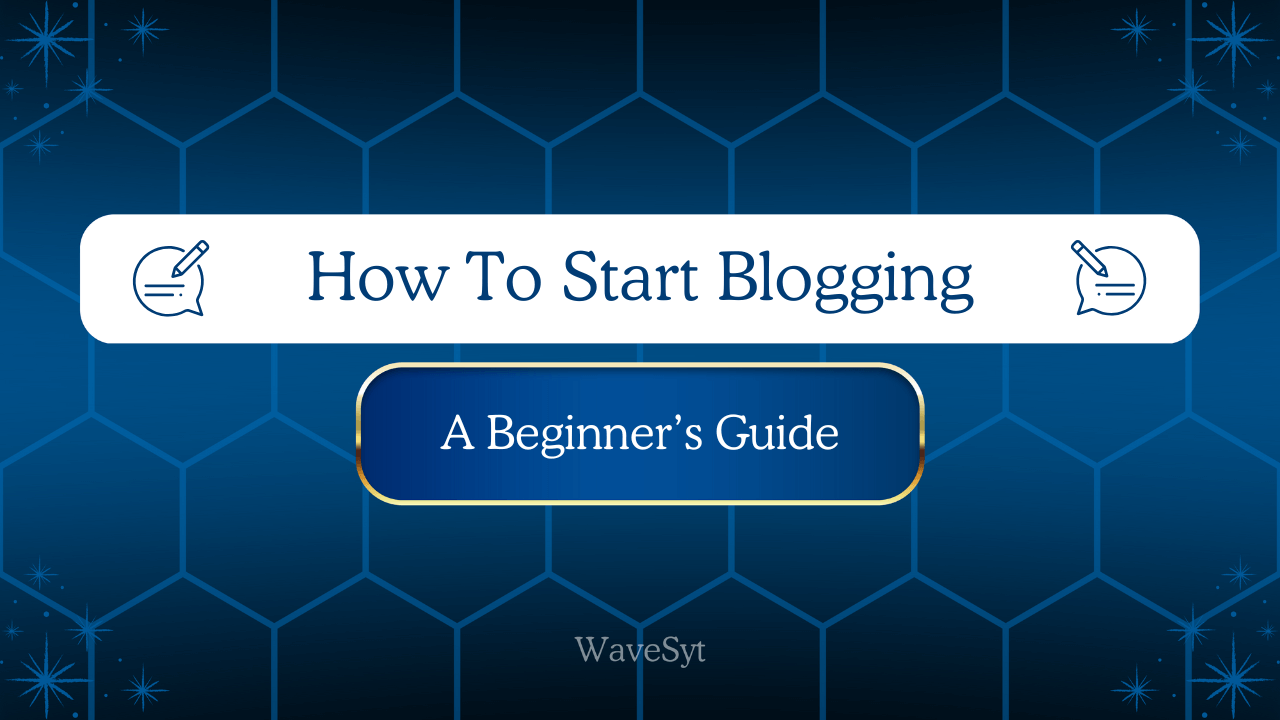Have you ever dreamed of sharing your ideas, experiences, or passions with the world but felt daunted by the thought of creating a blog? Good news – you don’t need to be a coding expert or spend a fortune to start. Blogging is easier than ever, and this guide will take you through the process step-by-step.
Whether you want to write about food, travel, or even niche topics like eco-friendly crafts, your blog can be your creative outlet or a side hustle. Let’s dive in and get started!
Why Blogging Is Still Valuable?
Blogging might feel like a thing of the past with all the short-form content online, but it’s far from outdated. It’s one of the best ways to dive deep into topics, showcase your expertise, and connect with like-minded readers.
What Can Blogging Offer You?
- Share Your Voice: Express your thoughts, hobbies, and expertise in your corner of the internet.
- Depth and Insight: Unlike social media, blogs allow for long-form content where you can explore topics in detail and showcase your expertise.
- Longevity: Blog posts don’t disappear into a timeline; they remain accessible, searchable, and relevant for years.
- Connection: Blogging allows you to connect with like-minded individuals, creating a community of readers who appreciate your perspective.
- Earn Money: Blogs can generate income through ads, affiliate marketing, or selling products.
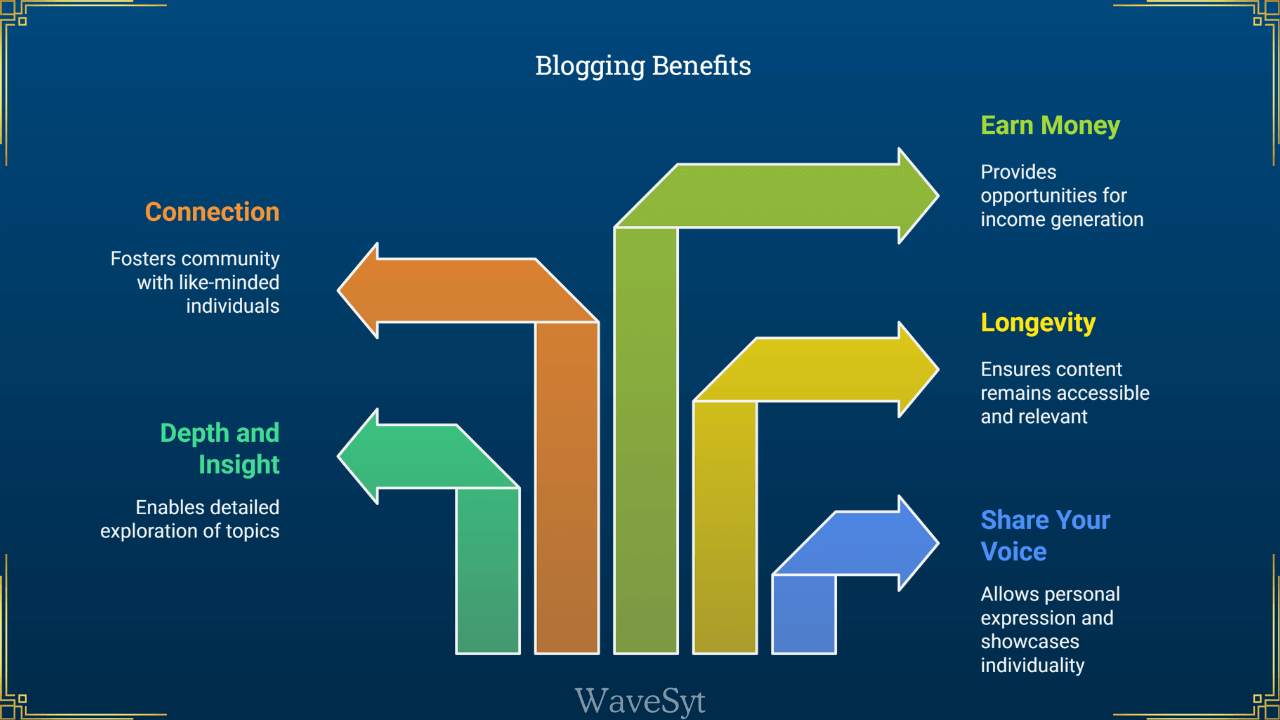
Pro Tip: Search engines like Google love blogs. A well-written, SEO-optimised blog can become a reliable source of organic traffic, helping you grow your audience over time.
How To Start Blogging: A Beginner’s Guide
1. Types of Blogs You Can Start:
Your blog should reflect your interests and goals. Here are some common types to consider:
- Personal Blogs: You can start blogging as a digital diary where you share your life, thoughts, and experiences.
- Niche Blogs: Cover specific topics like travel, fitness, or tech.
- Business Blogs: Showcase your company, product, or services while building trust with your audience.
- Affiliate Blogs: Focus on reviewing products and earning commissions through affiliate links.
Pro Tip: Start with what excites you the most—it’s easier to stay motivated when you’re passionate about your blog’s subject.
2. Choosing The Right Niche:
A niche is the specific topic your blog focuses on. For example, instead of writing about general fitness, you could focus on “strength training for busy moms.” A blog without direction is like a ship without a sail—it drifts aimlessly. Before diving into the technical aspects, ask yourself these key questions:
- What excites me?
Choose a topic you’re passionate about. Love fitness? Start a blog about home workouts. Enjoy baking? Share your recipes and kitchen adventures. - What value can I offer?
Think about your skills or expertise. For example, if you’re great at budgeting, you can create a finance-focused blog. - Who is my audience?
You have to find your readers while blogging. Are they beginners in your niche? Experts looking for fresh perspectives? You can use tools like ahrefs or Ubersuggest to see if people are searching for your topic.
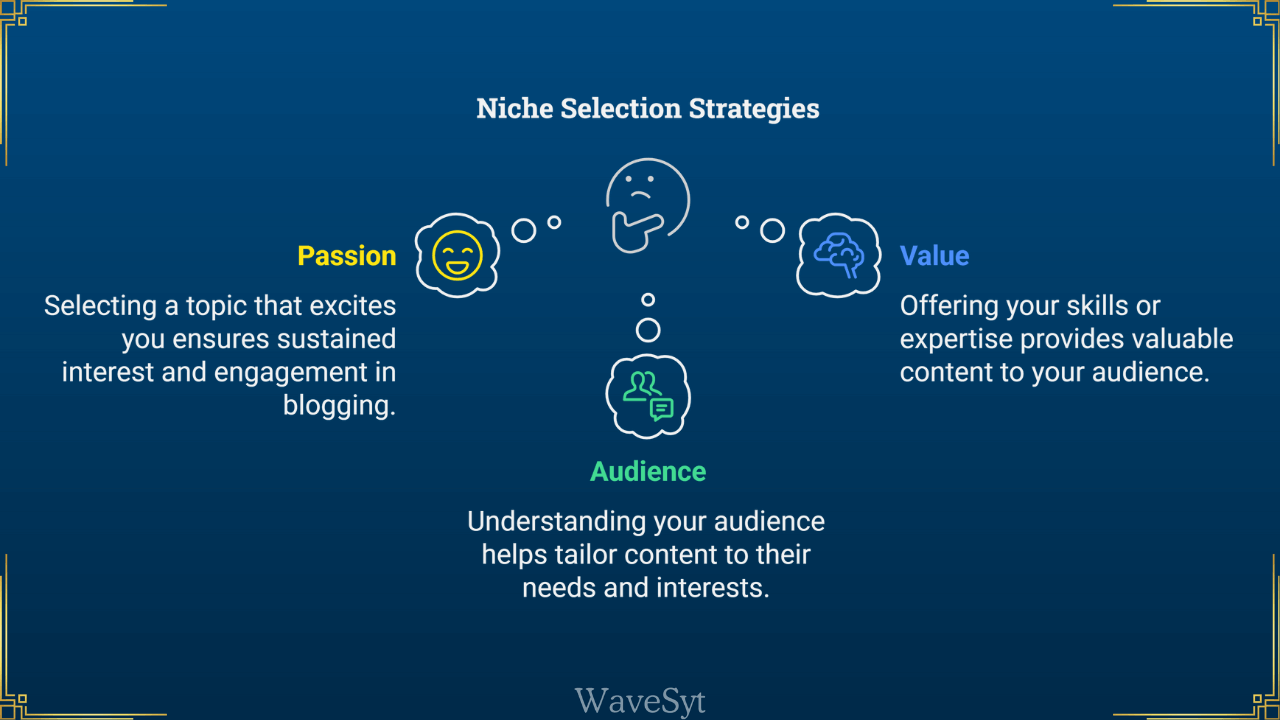
| Niche | Description | Example Blog |
|---|---|---|
| Lifestyle | Cover diverse topics like wellness, travel, and fashion | “Simplify Your Days” |
| Food and Recipes | Share recipes, cooking tips, or restaurant reviews | “The Curious Chef” |
| Personal Finance | Teach budgeting, saving, or investing | “Penny-Wise Living” |
| Tech and Gadgets | Review the latest gadgets and apps | “The Digital Geek” |
Pro Tip: A micro-niche, like “eco-friendly DIY crafts for kids,” can make you stand out in a crowded market.
3. Picking A Blogging Platform:
Your blogging platform is where your blog will live—think of it as your blog’s home base. There are lots of options, but some are better for beginners.
- Free Platforms: Great for beginners but limited in customization and monetization. Popular options include Blogger, Wix and WordPress.com.
- Paid Platforms: Ideal if you’re serious about blogging. WordPress.org is a favourite because it offers flexibility and ownership.
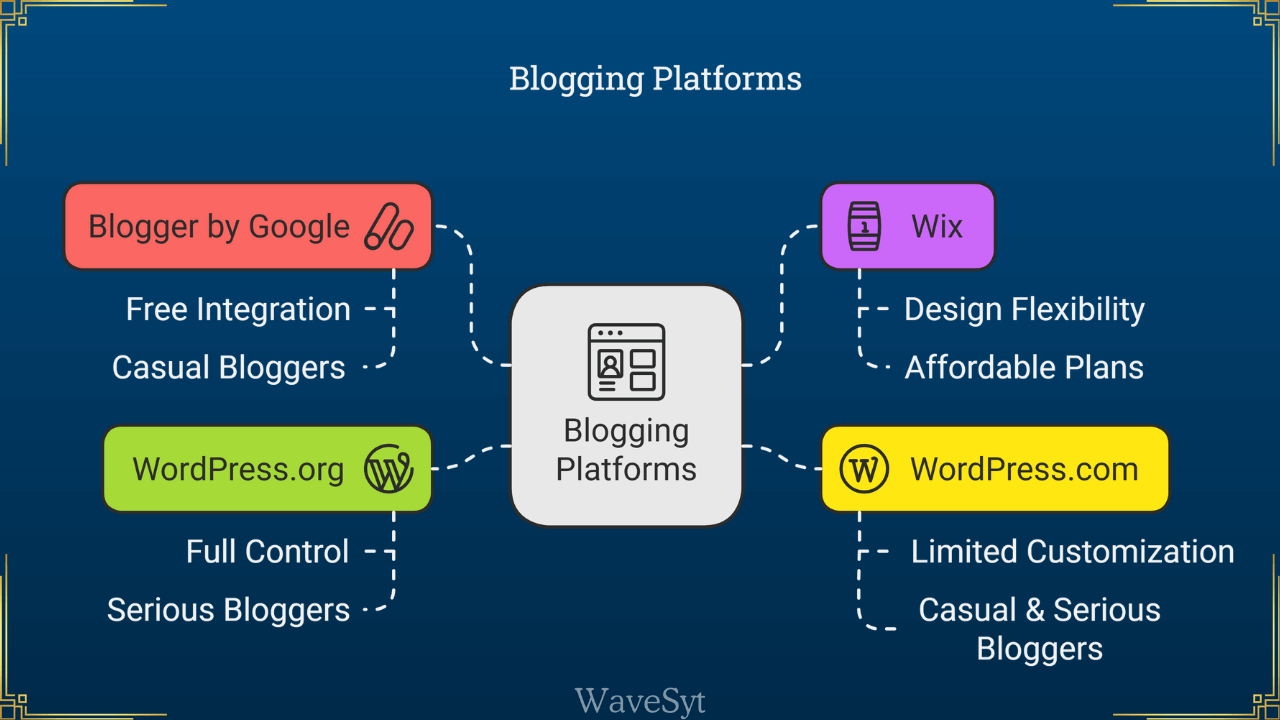
Top Blogging Platforms for Beginners:
- Blogger by Google
- Why Choose It? Simple, free, and integrated with Google services. Great for beginners and hobby bloggers.
- Ideal For: Casual bloggers who want a straightforward blogging platform without hosting costs.
- Starting Cost: Free. Premium features, like custom domain names, can be purchased separately.
- Wix
- Why Choose It? Drag-and-drop editor with no coding needed. Affordable premium plans include hosting.
- Ideal For: Creative bloggers who want flexibility with design.
- Starting cost: $2/month or ₹ $ 150/month for premium features.
- WordPress.com
- Why Choose It? Free to start, simple, and perfect for hobby blogs.
- Ideal For: Casual bloggers who want an easy, no-fuss setup.
- Limitations: Limited customisation unless you upgrade
- WordPress.org (Self-hosted)
- Why Choose It? Highly customisable with full control over your site. Ideal for long-term growth.
- Ideal For: Bloggers serious about expanding their platform and earning income.
- Cost: Hosting plans start at $1.78/month or ₹149/month with providers like Hostinger.
4. Set Up Your Blog:
Your blog’s name is like your personal brand—it’s how readers will remember you. Remember the following tips before picking the name of the blog:
- Keep It Short and Simple: Avoid long, complex names that are hard to type or remember.
- Be Relevant: Include words that hint at your niche (e.g., “Baker’s Delight” for a baking blog).
- Check Availability: Use tools like Namecheap or GoDaddy to see if your domain is available.
Pro Tip: If your preferred domain name isn’t available, add modifiers like “My,” “The,” or “Guide” to make it unique.
Once you’ve picked a name (e.g., wavesyt.com), buy it and secure your domain. Domains usually cost $10–$15/year (₹800–₹1,200).
Example Name Ideas:
| Travel Blog | “Wanderlust Diaries” |
| Fitness Blog | “Fit in Five” |
Let’s take a look at what are needed to start and set up a blog.
- Hosting (For WordPress Users): This is where your blog’s files are stored. Reliable options include Bluehost and Hostinger. Hosting starts at $1.78/month or ₹149/month.
- Theme: Choose a blog design template that reflects your style. Free themes work great for starters, but premium ones offer more features.
- Plugins (For WordPress Users):
- SEO: Helps optimise your blog for search engines.
- Forms: Add contact forms to your site.
For Blogger Users:
- Go to Blogger and sign in with your Google account.
- Click “Create Blog” and follow the prompts to name your blog and choose a template.
For WordPress.org Users:
- Purchase hosting from a reliable provider like Hostinger or Bluehost.
- Install WordPress through your hosting dashboard.
- Choose and customise a theme.
Pro Tip: Choose a mobile-responsive theme, as most readers will visit your blog from their phones. We have an article on “How To Create A Website“. You can check it out.
5. Craft Engaging, SEO-Friendly Content:
Your content is the heart of your blog. Make it count!
Blog Post Structure:
- Headline: Catch attention instantly. Example: “5 Quick Home Workouts for Busy Parents”
- Introduction: Start with a relatable question or a hook.
- Body: Break it into sections with subheadings. Use bullet points for clarity.
- Conclusion: Summarise key takeaways and include a call-to-action (e.g., “Subscribe for updates!”).
Ideas for Your First Posts:
- A welcome post introducing yourself and your blog’s mission.
- How-to guides related to your niche (e.g., “How to start a home garden”).
- Listicles (e.g., “Top 10 tools for gardening”).
- High-quality images, videos, and interactive polls enhance engagement and retention.
Keep it conversational and genuine. Authenticity helps readers connect. Search Engine Optimization (SEO) helps your blog get noticed by search engines like Google.
Simple SEO Tips:
- Use Keywords: Sprinkle relevant keywords naturally throughout your content.
- Example: Use “easy baking tips” if that’s your niche.
- Add Alt Text to Images: Describe images to make your blog accessible and boost rankings.
- Create Internal Links: Link to other posts on your blog to keep readers engaged.
Pro Tip: Avoid “keyword stuffing.” Instead, naturally include your keywords in headings and throughout your post.
6. Promoting Your Blog:
Social Media Strategies:
- Pick the Right Platforms: Pinterest works well for DIY, while Instagram shines for lifestyle content.
- Create Shareable Posts: Use eye-catching images and engaging captions.
- Engage with Followers: Reply to comments and host Q&A sessions to build relationships.
Collaborating with Bloggers:
- Guest Posts: Write for other blogs to reach new audiences.
- Content Partnerships: Team up for eBooks, webinars, or campaigns.
- Cross-Promotion: Share each other’s content on social media.
7. Making Money From Blogging:
- Affiliate Marketing: Earn a commission by promoting products.
- Sponsored Posts: Collaborate with brands to create content for a fee.
- Sell Products: Offer eBooks, courses, or templates related to your niche.
- Ads: Use networks like Google AdSense to earn from clicks.
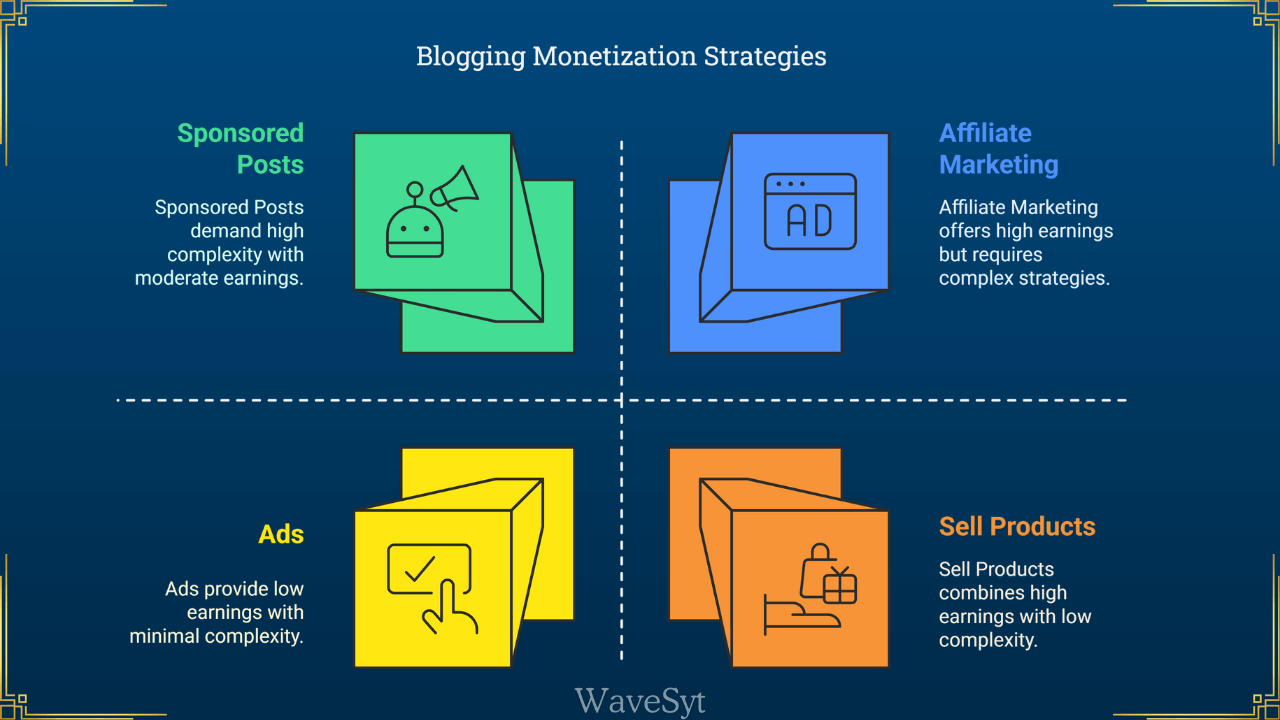
| Method | Potential Earnings (Per Month) |
|---|---|
| Google AdSense | $5–$250+ (₹500–₹20,000+) |
| Affiliate Marketing | $15–$600+ (₹1,000–₹50,000+) |
| Sponsored Posts | $60+ (₹5,000+) per post |
| Sell Products | $15–$600+ (₹1,000–₹50,000+) |
8. Staying Consistent And Growing:
- Plan Ahead: Use a content calendar to stay organised.
- Analyse Performance: Tools like Google Analytics help you track what’s working.
- Stick to a Schedule: Consistency builds trust with your audience.
Final Thoughts: Start Your Blogging Journey Today
Congratulations! You’ve taken the first steps toward creating something truly special—your blog. Whether your goal is to express yourself, connect with like-minded people, or even monetise your passion, remember that blogging is a journey. It’s not just about the words on a screen; it’s about the connections you build, the knowledge you share, and the impact you make.
Starting a blog might seem daunting at first, but it’s entirely doable if you take it step by step. Choose a niche that excites you, pick the right platform, and create actual value content. Remember, every successful blog started as a small idea. Stay consistent, experiment, and most importantly, enjoy the process. Who knows? This could be the start of something extraordinary. Happy Blogging!
Frequently Asked Questions:
What are the best blogging platforms for beginners?
The top blogging platforms for beginners include:
- WordPress.org: Best for serious bloggers who want full control and customisation.
- WordPress.com: Free and user-friendly, ideal for hobbyists.
- Wix: Offers a drag-and-drop interface, perfect for creative bloggers.
- Blogger: Great for beginners and hobby bloggers. It is free of cost unless you use any custom domain.
How can I choose the right niche for my blog?
To find your niche, start with your interests and skills. Consider what excites you and what knowledge you possess that others may find valuable. Tools like Google Trends can help assess market demand for your chosen topic.
What should I include in my first blog post?
Your first blog post should introduce yourself and outline your blog’s mission. You might also consider writing how-to guides or listicles related to your niche to engage readers immediately.
What are some basic SEO tips for new bloggers?
To optimise your blog for search engines:
- Use relevant keywords naturally throughout your content.
- Add alt text to images for better accessibility and SEO.
- Create internal links to keep readers engaged with your other posts.
How can I promote my blog effectively?
Promoting your blog can be done through:
- Sharing posts on social media platforms like Instagram and Pinterest.
- Building an email newsletter to keep subscribers updated.
- Guest blogging on related sites to reach new audiences.
What are some ways to monetise my blog?
Once your blog gains traction, consider monetising it through:
- Affiliate marketing by recommending products.
- Displaying ads using platforms like Google AdSense.
- Selling digital products like eBooks or online courses related to your niche.
How often should I post on my blog?
Consistency is key! Aim to publish one or two weekly posts to build a loyal audience. Creating a content calendar can help you plan and stay organised.

